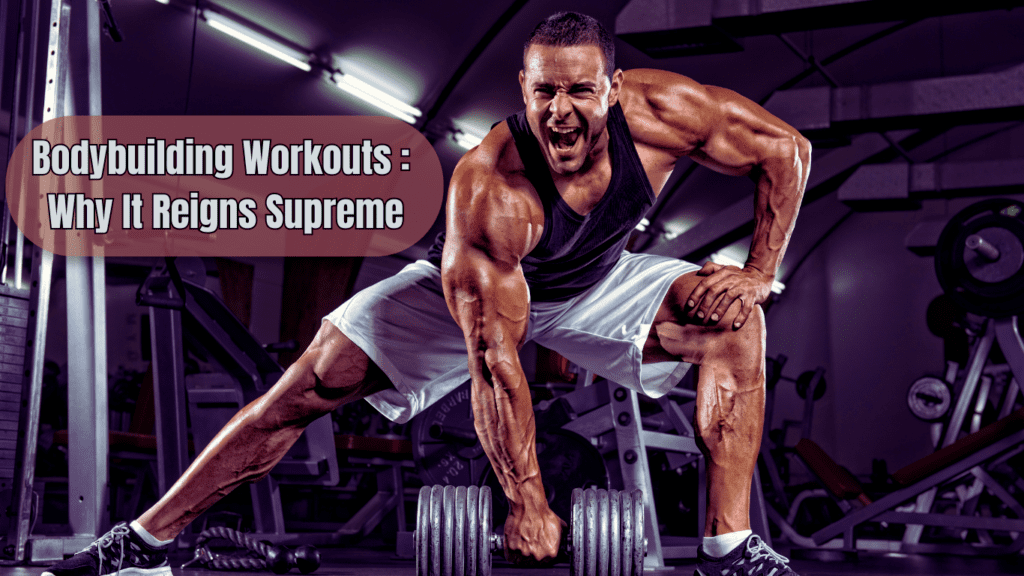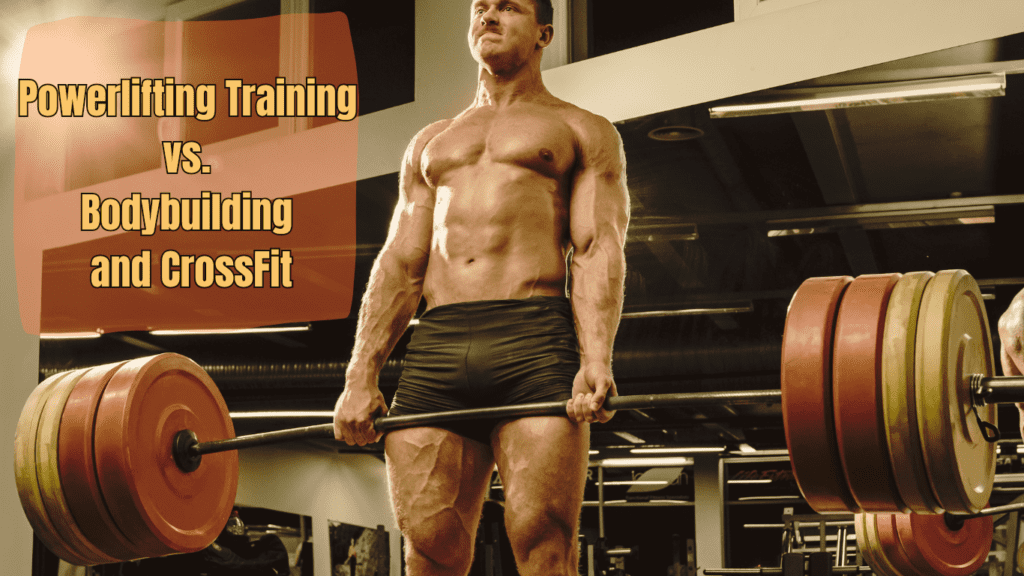Introduction to The Big Three Lifts: Why They Matter in Powerlifting
In this article, we’ll uncover the secrets of the big three lifts in powerlifting—the squat, bench press, and deadlift—showing you how to master these fundamental exercises for optimal strength and performance.
Imagine stepping into a room where the weight of the world literally rests on your shoulders. You’re about to attempt a lift that requires every ounce of strength you can muster. This is the essence of powerlifting—a sport defined not just by muscle, but by the sheer will to move monumental amounts of weight. At the heart of powerlifting are the big three lifts: the squat, the bench press, and the deadlift. These three exercises form the foundation of the sport and are critical for building overall strength.

The significance of the big three lifts extends far beyond the powerlifting community. They are cornerstones in strength training, used by athletes across various disciplines to improve performance, increase muscle mass, and enhance overall functional strength. These lifts are not merely exercises; they are a test of power, technique, and endurance.
In this article, we will delve into the big three lifts, exploring why they are so crucial and how mastering them can lead to significant gains in strength and fitness. Our goal is to provide you with a comprehensive understanding of these fundamental movements, teaching you how to execute them correctly and explaining the science that makes them so effective.
The squat, often considered the king of all exercises, engages multiple muscle groups simultaneously, making it an incredible full-body workout. It’s not just about pushing yourself up from a seated position; it’s about engaging your core, legs, and back to maintain stability and power. We’ll discuss the correct form and common mistakes to avoid, ensuring you get the most out of every rep.
Next, we’ll look at the bench press, an exercise that targets the upper body, focusing on the chest, shoulders, and triceps. This lift is a staple in any strength training regimen and is vital for building upper body strength. Understanding the nuances of the bench press, including grip width and elbow positioning, will help you lift more efficiently and reduce the risk of injury.
Subscribe And Get Our Free E-Book:Unlocking The Power Of Nutrition-Supplements, Substitutes, and Superfoods!
Finally, we’ll cover the deadlift, an exercise that many consider the ultimate test of strength. The deadlift involves lifting a barbell from the ground to hip level, engaging muscles throughout your entire body. We’ll break down the proper technique, address common pitfalls, and explore how this lift contributes to overall strength development.
By the end of this article, you’ll not only appreciate the importance of the big three lifts but also possess the knowledge to perform them with proper form and technique. Whether you’re a seasoned lifter or new to strength training, understanding and mastering these exercises will enhance your training and help you achieve your fitness goals.
Stay tuned as we dive deeper into each of the big three lifts, uncovering the secrets to optimizing your performance and building unshakable strength.
Squat Deadlift Benchpress The Big Three Video
The Big Three Lifts Overview
When diving into the world of strength training and powerlifting, the term the big three lifts inevitably comes up. These three fundamental exercises—the squat, bench press, and deadlift—are more than just routines; they are the pillars of powerlifting and essential components of any comprehensive strength program. Let’s break down each of these lifts and understand their significance.
The Squat is often regarded as the most challenging and rewarding of the the big three lifts. This exercise involves lowering your body by bending your knees and hips, then rising back to a standing position. The squat primarily targets the quadriceps, hamstrings, and glutes, but it also engages the core and lower back for stability. When done correctly, squats can enhance lower body strength, improve balance, and increase overall power. They are crucial not only in powerlifting but in various athletic activities where lower body strength is paramount.
The Bench Press focuses on the upper body, particularly the chest, shoulders, and triceps. In this lift, you lie on a bench and push a barbell away from your chest until your arms are fully extended, then lower it back down. The bench press is a fundamental exercise in the big three lifts because it plays a critical role in developing upper body strength and muscle mass. It’s often used as a benchmark for measuring upper body strength and is essential for pushing movements in sports and daily activities.
The Deadlift is considered by many to be the ultimate test of strength. In this exercise, you lift a barbell from the ground to hip level while keeping your back straight and your core engaged. The deadlift targets the posterior chain, including the hamstrings, glutes, and lower back, but it also involves the upper body, including the grip and forearms. As a part of the big three lifts, the deadlift is invaluable for developing overall strength and power, improving posture, and enhancing functional fitness. It’s a compound movement that tests and builds strength across multiple muscle groups.

Why The Big Three Lifts Matter
Understanding the importance of the big three lifts goes beyond just knowing what they are. Each lift plays a unique role in powerlifting and strength training, contributing to overall strength development and functional fitness.
In powerlifting competitions, these three lifts are the core events. Competitors perform the squat, bench press, and deadlift, and their combined totals determine their final score. Mastery of these lifts is essential for anyone serious about powerlifting, as they test maximal strength in different muscle groups and movement patterns.
Beyond the competitive realm, the big three lifts are fundamental to general strength training for several reasons. They target major muscle groups, which is crucial for balanced strength development. For instance, the squat engages almost the entire lower body, which is essential for movements like jumping, running, and even walking. The bench press builds upper body strength, which is critical for pushing movements in various sports and daily activities. The deadlift strengthens the posterior chain, which supports good posture and reduces the risk of injury.
In addition to targeting major muscle groups, these lifts contribute to functional fitness. Functional fitness refers to exercises that mimic everyday activities, making daily tasks easier and reducing the risk of injury. By incorporating the big three lifts into your training routine, you develop strength that directly translates to improved performance in daily activities and sports.
Moreover, these lifts are integral to creating a well-rounded strength training program. They complement other exercises by providing a strong foundation. For example, a well-executed squat can enhance the effectiveness of leg exercises, while a strong bench press can improve performance in overhead movements. The deadlift, with its focus on the posterior chain, can enhance stability and strength for various lifting and pulling tasks.
To sum up, the significance of the big three lifts cannot be overstated. They are more than just exercises; they are the cornerstone of powerlifting and a key component of any effective strength training regimen. Each lift targets major muscle groups, contributes to functional fitness, and plays a crucial role in building overall strength. Understanding and mastering the big three lifts will not only improve your performance in the gym but also enhance your daily life and athletic abilities.
The Big Three Lifts: Powerlifting Essentials Chart
| Lift | Primary Muscles | Powerlifting Significance | Injury Prevention | Caloric Burn (approx./hour) |
|---|---|---|---|---|
| Squat | Quads, Hamstrings, Glutes, Core | Foundation for lower body strength and stability | Supports knee and hip joints, protects lower back | 400-500 |
| Bench Press | Pectorals, Triceps, Shoulders | Measures upper body pushing power and overall strength | Strengthens shoulders, reducing impingement risk | 300-400 |
| Deadlift | Hamstrings, Glutes, Lower Back, Core | Ultimate test of full-body strength and pulling power | Improves posture, protects lower back and core stability | 500-600 |
Why It Matters for Powerlifting:
- Total Strength: Each lift targets key muscle groups, crucial for powerlifting totals.
- Max Force: Mastering these lifts increases overall power output.
- Injury Prevention: Proper form reduces strain on joints and muscles, ensuring longevity in the sport.
The Squat: A Detailed Guide to Mastering This Essential Lift
Among the big three lifts, the squat is often hailed as the most fundamental and challenging. This exercise not only tests your strength but also plays a crucial role in developing lower body power and overall stability. To truly master the squat, it’s essential to understand the muscles it targets, the proper technique, common mistakes, variations, and the scientific principles behind its effectiveness. Let’s break it down.
Muscles Worked
The squat is a compound exercise that engages several muscle groups simultaneously. The primary muscles targeted include:
- Quadriceps: These are the muscles at the front of your thighs. They play a significant role in extending your knees during the squat.
- Hamstrings: Located at the back of your thighs, these muscles help in bending your knees and extending your hips.
- Glutes: The gluteal muscles, or glutes, are crucial for hip extension and contribute to the upward phase of the squat.
- Lower Back: The lower back muscles, including the erector spinae, stabilize your spine during the movement.
In addition to these primary muscles, the squat also engages secondary muscles such as the calves, core, and even the upper body to maintain balance and posture.
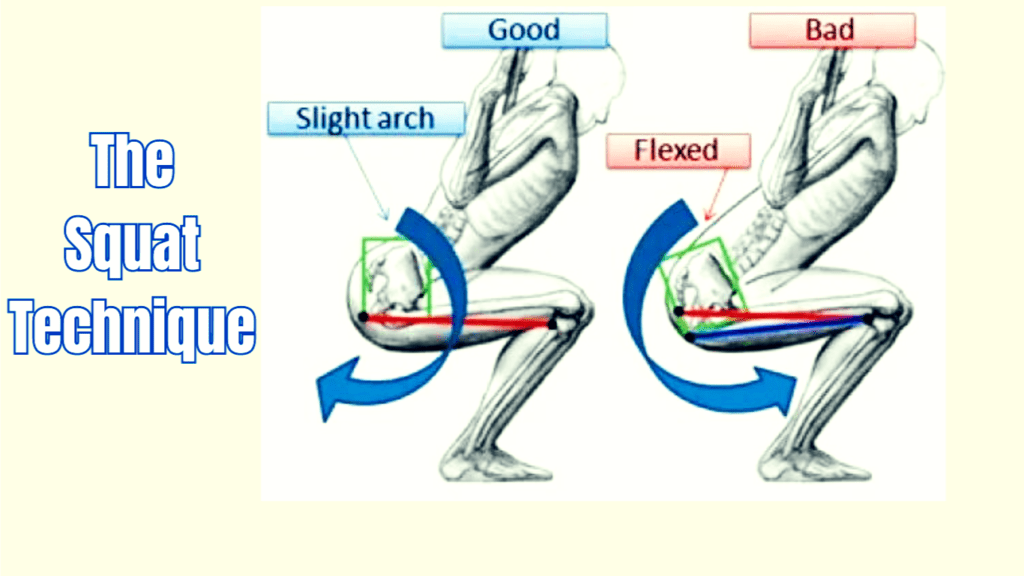
Proper Form
Mastering the squat requires attention to detail in technique. Here’s a step-by-step guide to performing the squat with proper form:
- Foot Placement: Stand with your feet shoulder-width apart. Your toes should be slightly pointed outward, around 15 to 30 degrees, to allow for a natural movement pattern.
- Bar Positioning: If using a barbell, position it across your upper traps, not on your neck. Ensure that the bar is centered and balanced.
- Depth: Lower yourself by bending at the hips and knees, keeping your chest up and your back straight. Aim to lower your body until your thighs are at least parallel to the ground. Going deeper can be beneficial if you maintain proper form.
- Breathing Techniques: Inhale deeply before starting the descent and hold your breath (Valsalva maneuver) to maintain intra-abdominal pressure. Exhale as you push back up to the starting position.
Common Mistakes
Several common errors can undermine the effectiveness of your squat and increase the risk of injury. Here’s how to avoid them:
- Knees Caving In: Ensure your knees track over your toes throughout the movement. Avoid letting them cave inward, which can place undue stress on your joints. Strengthen your hip abductors and improve your technique to address this issue.
- Not Reaching Full Depth: Squatting to only partial depth can limit the effectiveness of the exercise. Aim to squat to at least parallel to the ground, or deeper if possible, while maintaining proper form. Work on flexibility and mobility to achieve a full range of motion.
- Leaning Forward: Keep your chest up and your back straight. Leaning too far forward can lead to back strain and reduced effectiveness. Focus on engaging your core to maintain an upright posture.
Variations
Incorporating different squat variations can help target different muscle groups and add variety to your workout. Some popular variations include:
- Front Squat: In this variation, the barbell is positioned across the front of your shoulders. It places more emphasis on the quadriceps and requires greater core stability.
- Box Squat: Perform this squat by sitting back onto a box or bench before standing up. It can help improve squat depth and technique, and is useful for building explosive power.
- Goblet Squat: Holding a dumbbell or kettlebell close to your chest, this variation emphasizes proper squat mechanics and helps improve flexibility and balance.
Scientific Insight
Biomechanics: The biomechanics of the squat involve complex interactions between joints and muscles. As you descend, your hips and knees flex while your ankles dorsiflex. The activation of muscles and changes in joint angles contribute to the force production required to complete the lift. Proper biomechanics ensure efficient movement patterns and minimize injury risk.
Why It Works: The squat is highly effective for building lower body strength because it engages multiple muscle groups simultaneously. This compound movement not only improves muscle mass but also enhances functional strength. Additionally, the squat helps improve athletic performance by developing explosive power and stability, which are crucial for various sports.
Practical Tips
How to Progress: Progressing with squats involves gradually increasing the weight, volume, or complexity of the exercise. Start with lighter weights and focus on perfecting your technique. Once you’re comfortable, incrementally add weight or increase the number of repetitions and sets. Incorporate advanced variations to further challenge yourself.
Injury Prevention: To avoid injuries while squatting, prioritize proper warm-up exercises and mobility work. Stretching the muscles involved and performing dynamic warm-ups can prepare your body for the demands of the squat. Additionally, manage your load carefully to avoid overtraining and allow adequate recovery between sessions.
Mastering the squat, one of the big three lifts, requires attention to detail in form, understanding the targeted muscles, and incorporating effective variations. By focusing on proper technique, addressing common mistakes, and applying scientific principles, you can enhance your strength and performance. Whether you’re aiming to improve your powerlifting skills or simply looking to build lower body strength, the squat is an essential component of a successful training regimen.
The Bench Press
The bench press stands as a cornerstone among the big three lifts, integral to developing upper body strength and power. This exercise is essential not only for powerlifters but for anyone seeking to enhance their overall fitness. To get the most out of the bench press, it’s crucial to understand the muscles it targets, the correct form, common mistakes, variations, and the science behind its effectiveness. Let’s dive into the details.
Muscles Worked
The bench press is a compound exercise that primarily targets the upper body, engaging several key muscle groups:
- Chest: The pectoral muscles are the primary movers in the bench press. They are responsible for pushing the barbell away from your chest.
- Shoulders: The deltoid muscles assist in the pressing movement, particularly the anterior (front) delts.
- Triceps: The triceps brachii on the back of the upper arms are crucial for extending the elbows during the lift.
- Stabilizing Muscles: The bench press also engages stabilizing muscles, including the rotator cuff muscles and the muscles of the upper back, which help maintain balance and proper form throughout the lift.
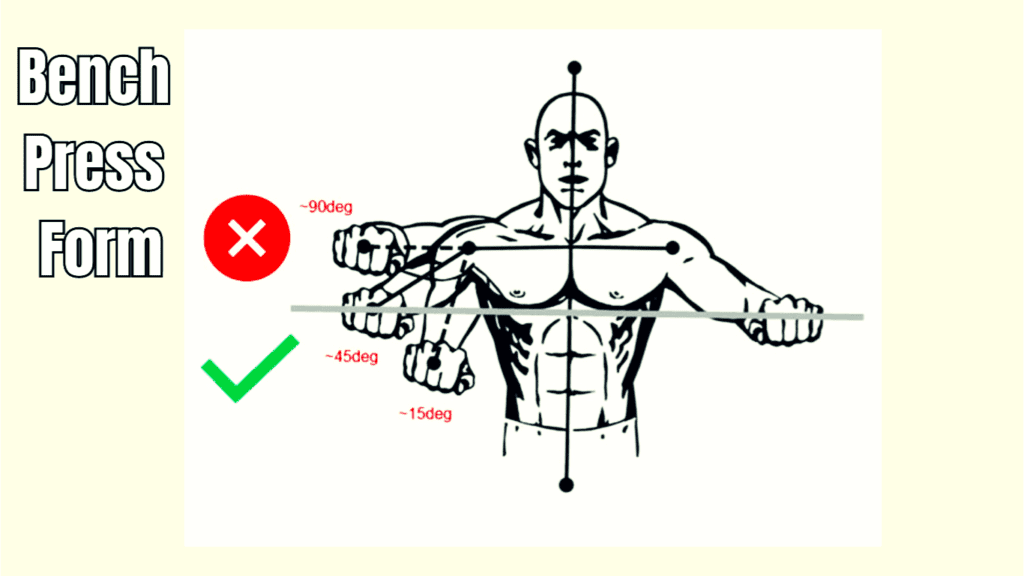
Proper Form
Achieving proper form in the bench press is essential for maximizing effectiveness and minimizing injury risk. Here’s a step-by-step guide:
- Hand Placement: Grip the barbell slightly wider than shoulder-width apart. Your hands should be evenly spaced, with your thumbs wrapped around the bar for safety.
- Bar Path: Lower the barbell to your chest, aiming for the area just below the nipples. The bar should move in a controlled, straight line. Push the bar back up in the same path to the starting position.
- Elbow Positioning: Keep your elbows at a 45-degree angle to your body as you lower the bar. Avoid flaring your elbows out too much, as this can place undue stress on your shoulders.
- Maintaining Tightness: Engage your core, keep your feet firmly planted on the floor, and maintain a slight arch in your lower back. This tightness helps stabilize your body and provides a solid base for the lift.
Common Mistakes
Several common errors can hinder your performance and increase the risk of injury during the bench press. Here’s how to avoid them:
- Flaring Elbows: When your elbows flare out excessively, it places excessive strain on your shoulder joints. Keep your elbows at a 45-degree angle to your torso to protect your shoulders and maximize muscle engagement.
- Arching Back Excessively: A natural arch in the lower back is normal, but excessive arching can strain the lower back and reduce stability. Focus on keeping your glutes and feet in contact with the bench and floor to maintain a proper and safe arch.
- Bar Path Issues: If the barbell moves too far forward or backward, it can affect the effectiveness of the lift and increase the risk of injury. Ensure the bar follows a vertical path and remains aligned with your mid-chest.
Variations
Incorporating variations of the bench press can target different muscle groups and add variety to your workout. Some effective variations include:
- Incline Bench Press: Performed on an incline bench, this variation places more emphasis on the upper part of the chest and the shoulders. It’s useful for developing upper chest strength and improving overall pressing power.
- Decline Bench Press: Done on a decline bench, this variation focuses on the lower part of the chest and can provide a different angle of resistance. It’s effective for building overall chest mass and strength.
- Close-Grip Bench Press: With a narrower hand placement, this variation targets the triceps more intensely and reduces the emphasis on the chest. It’s ideal for improving triceps strength and bench press lockout.
Scientific Insight
Biomechanics: The bench press involves the coordinated movement of the shoulder and elbow joints. As you press the barbell upward, the shoulder joints undergo horizontal adduction, while the elbows extend. The engagement of the pectoral muscles, deltoids, and triceps facilitates this movement. Proper alignment and muscle activation are crucial for efficient force production and injury prevention.
Why It Works: The bench press is highly effective for building upper body strength due to its focus on the major pushing muscles. By engaging multiple muscle groups simultaneously, the bench press promotes muscle hypertrophy and strength development. Its compound nature ensures that you build power and endurance in the chest, shoulders, and triceps, which translates to improved performance in various athletic and daily activities.
Practical Tips
How to Progress: Progressing with the bench press involves several strategies. Start by refining your technique and ensuring proper form. Gradually increase the weight you lift, ensuring that you maintain good form throughout. Incorporate accessory exercises, such as tricep dips or shoulder presses, to strengthen supporting muscles and improve overall pressing power.
Injury Prevention: To avoid shoulder injuries and ensure safe lifting, begin with a thorough warm-up that includes dynamic stretches and mobility exercises for the shoulders. Maintain balanced muscle development by incorporating exercises that target the opposing muscle groups, such as rows and reverse flyes. Additionally, avoid overloading the barbell and listen to your body to prevent overtraining.
The bench press is a critical component of the big three lifts and a powerful exercise for developing upper body strength. By understanding its muscle engagement, mastering proper form, addressing common mistakes, and exploring variations, you can optimize your bench press performance. Applying scientific insights and practical tips will help you progress safely and effectively, making the bench press a valuable addition to your strength training routine.
The Deadlift
The deadlift is a cornerstone of the big three lifts and is renowned for its ability to build total body strength. It is an essential lift for anyone serious about strength training and powerlifting. To fully benefit from the deadlift, it’s crucial to understand the muscles it works, the proper form, common mistakes, variations, and the scientific principles behind its effectiveness. Let’s break down this important lift in detail.
Muscles Worked
The deadlift is a powerful compound exercise that primarily targets the posterior chain. The main muscles involved include:
- Hamstrings: Located at the back of your thighs, the hamstrings are critical for extending your hips and knees during the lift.
- Glutes: The glute muscles, or glutes, play a significant role in hip extension and contribute to the upward phase of the deadlift.
- Lower Back: The erector spinae muscles in the lower back are essential for stabilizing your spine and maintaining proper posture throughout the lift.
- Grip Strength: Holding onto the barbell requires significant grip strength, which is also developed through regular deadlifting.
- Core Stability: Your core muscles, including the abdominals and obliques, help stabilize your torso and maintain proper alignment during the lift.
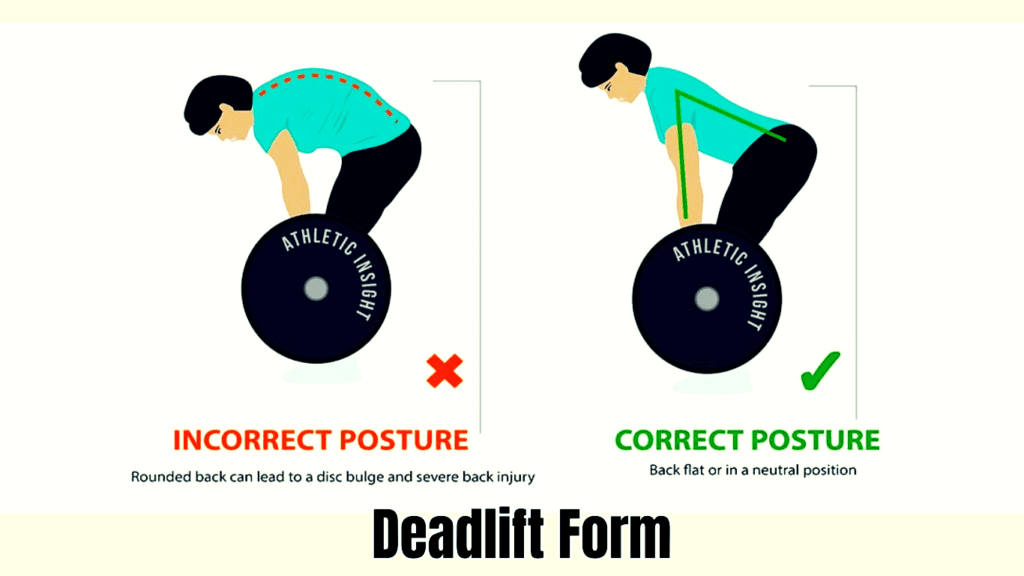
Proper Form
Achieving proper form in the deadlift is crucial for maximizing effectiveness and preventing injury. Follow these step-by-step instructions:
- Stance: Stand with your feet hip-width apart, and position the barbell over the middle of your feet. Your toes can be slightly pointed outward to accommodate natural movement.
- Grip: Reach down and grasp the barbell with both hands. You can use an overhand grip (palms facing you) or a mixed grip (one palm facing you, one palm facing away) depending on what feels most comfortable and secure.
- Back Positioning: Keep your back flat and your chest up as you prepare to lift. Engage your lats (latissimus dorsi) and pull your shoulder blades back to maintain proper spinal alignment.
- Lift Off: Drive through your heels and extend your hips and knees simultaneously. Keep the barbell close to your body as you lift it. Avoid jerking or pulling with your arms; the lift should be driven by your legs and hips.
- Lockout: At the top of the lift, fully extend your hips and stand upright. Ensure your shoulders are back and your chest is up. Lower the barbell back to the ground in a controlled manner by hinging at the hips and bending your knees.
Common Mistakes
Several common errors can compromise the effectiveness of the deadlift and increase the risk of injury. Here’s how to correct them:
- Rounding the Back: One of the most common mistakes is rounding the lower back during the lift. This can lead to significant strain and potential injury. To avoid this, focus on maintaining a flat back and engaging your core throughout the lift. Imagine trying to puff your chest out and keep your shoulder blades pulled back.
- Poor Lockout: Failing to fully extend your hips at the top of the lift can result in incomplete muscle activation and reduced effectiveness. Make sure to fully extend your hips and stand tall at the top of the lift. A common cue is to “squeeze your glutes” at the top to ensure proper lockout.
- Barbell Drift: Allowing the barbell to drift away from your body can place extra strain on your lower back. Keep the bar as close to your body as possible throughout the lift, ensuring a straight bar path.
Variations
Incorporating different deadlift variations can help target various muscle groups and add variety to your training routine. Here are a few effective variations:
- Sumo Deadlift: Performed with a wider stance and hands inside the knees, the sumo deadlift places more emphasis on the inner thighs and glutes. It can be beneficial for lifters who have difficulty with hip mobility or who want to shift the focus of the lift.
- Trap Bar Deadlift: Using a trap bar (or hex bar) allows you to stand inside the barbell, which can reduce strain on the lower back and alter the lift’s mechanics. This variation is great for developing overall strength while minimizing back stress.
- Romanian Deadlift: This variation emphasizes the hamstrings and glutes more intensely. In the Romanian deadlift, you start from a standing position and lower the barbell by hinging at the hips while keeping your legs slightly bent. This targets the posterior chain more specifically.
Scientific Insight
Biomechanics: The biomechanics of the deadlift involve complex interactions between joints and muscles. The hip hinge movement is the primary action, where your hips move backward while your torso leans forward. Proper spinal alignment is crucial to avoid excessive stress on the lower back. The deadlift also involves the coordinated extension of the hips and knees, which generates the force required to lift the barbell.
Why It Works: The deadlift is a highly effective exercise for building total body strength because it engages multiple muscle groups simultaneously. It’s particularly beneficial for developing the posterior chain, which is vital for overall strength, posture, and functional movement. The deadlift also improves grip strength and core stability, which are essential for many other exercises and daily activities.
Practical Tips
How to Progress: To increase your deadlift strength, focus on accessory work such as hamstring curls, glute bridges, and back extensions to support your main lift. Improving grip strength through exercises like farmer’s walks or dead hangs can also be beneficial. Gradually increase the weight you lift, ensuring that you maintain proper form and technique.
Injury Prevention: Protecting your lower back during deadlifts is crucial. Begin with a thorough warm-up that includes dynamic stretches and mobility exercises for the hips and lower back. Consider using a lifting belt for additional support when lifting heavy weights, but avoid over-relying on it. Always prioritize proper form and listen to your body to prevent overtraining and injuries.
In conclusion, the deadlift is a critical lift among the big three lifts and offers numerous benefits for overall strength and functional fitness. By understanding the muscles worked, mastering proper form, addressing common mistakes, exploring variations, and applying scientific insights, you can enhance your deadlift performance and incorporate it effectively into your strength training regimen. Whether you’re aiming to improve powerlifting performance or simply build a stronger, more resilient body, the deadlift is an indispensable exercise.
Programming the Big Three: Structuring Your Training Around The Big Three Lifts
Incorporating the big three lifts—the squat, bench press, and deadlift—into your training regimen is crucial for building comprehensive strength and power. To maximize the benefits of these foundational exercises, it’s essential to structure your workout program effectively. This involves careful planning of frequency, volume, and intensity, ensuring a balanced approach to all three lifts, and understanding the concept of periodization. Here’s how you can program these key lifts to achieve optimal results.
Integrating the Big Three
When programming the big three lifts into your workout routine, it’s important to consider how often you perform each lift, the volume of work done, and the intensity of your efforts. Here’s a structured approach to integrating these lifts:
- Frequency: Aim to perform each of the big three lifts at least once per week. For beginners, this could mean a full-body workout that includes all three lifts in one session. More advanced lifters may benefit from splitting these lifts into separate training days to allow for greater focus and recovery. A common approach is to have a dedicated squat day, a bench press day, and a deadlift day, often with some form of accessory work included.
- Volume: The volume refers to the total amount of work done, typically measured by sets and repetitions. For strength development, focus on lower rep ranges (e.g., 3-5 reps per set) with heavier weights. For hypertrophy (muscle growth), higher volume with moderate weights and higher rep ranges (e.g., 6-12 reps per set) can be effective. Incorporate both approaches into your program, alternating between low and high volume phases to promote balanced development.
- Intensity: Intensity relates to the weight lifted relative to your maximum capacity. For strength gains, work with weights that are 70-85% of your one-rep max (1RM). For hypertrophy, use weights that are 60-75% of your 1RM. Incorporate intensity techniques such as progressive overload—gradually increasing the weight or number of reps over time—to continually challenge your muscles.
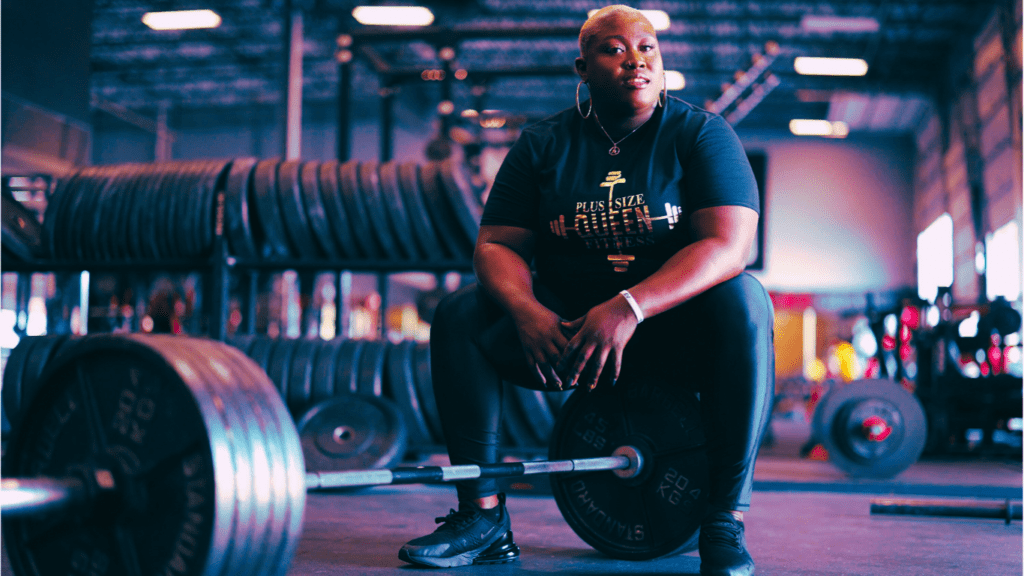
Balancing the Lifts
Balancing the big three lifts within your training program is crucial for ensuring all-around strength development and avoiding overtraining. Here’s how to achieve balance:
- Equal Attention: Ensure that each of the big three lifts receives adequate focus. Neglecting one lift in favor of another can lead to imbalances and hinder overall progress. For example, if you focus solely on the bench press, you might develop a stronger upper body but risk neglecting your lower body strength and overall functional balance.
- Accessory Work: Incorporate accessory exercises that complement and support the big three lifts. For instance, exercises like lunges and leg presses can enhance squat performance, while tricep extensions and shoulder presses can improve bench press strength. For deadlifts, accessory exercises like Romanian deadlifts and back extensions can build strength in the posterior chain.
- Recovery: Allow adequate recovery time between workouts targeting the same muscle groups. Overtraining can lead to fatigue and increased injury risk. Ensure your program includes rest days and lighter training phases to facilitate muscle repair and growth.
Periodization
Periodization is a systematic approach to training that involves cycling through different phases to optimize performance and prevent plateaus. In the context of the big three lifts, periodization can be broken down into several key phases:
- Hypertrophy Phase: This initial phase focuses on increasing muscle size and endurance. During this phase, use moderate weights and higher rep ranges to stimulate muscle growth. Incorporate a variety of exercises and volume to target different muscle groups and promote balanced development.
- Strength Phase: Following hypertrophy, shift your focus to building maximal strength. This phase involves lifting heavier weights with lower rep ranges. Emphasize compound movements like the big three lifts, and incorporate heavy sets with longer rest periods to enhance strength gains.
- Peaking Phase: The peaking phase is designed to maximize strength and performance for specific goals, such as a powerlifting competition or personal bests. During this phase, work with near-maximal weights and low rep ranges. Focus on perfecting technique and practicing lifts at or near your 1RM.
- Deload Phase: After a period of intense training, incorporate a deload phase to allow for recovery. This phase involves reducing the volume and intensity of your workouts to help your body recuperate and prepare for the next training cycle.
By following these phases and integrating the big three lifts strategically, you can enhance your performance and avoid stagnation. Periodization helps manage training loads and promotes continuous progress by varying the focus of your workouts over time.
Implementing Your Program
When designing a program around the big three lifts, consider your individual goals, experience level, and recovery capacity. Start with a basic framework and adjust it based on your progress and feedback from your body. Here’s a sample program outline to get you started:
- Day 1: Squat Focus: Perform the squat as your primary lift, followed by accessory exercises like leg presses and lunges. Finish with core work, such as planks or leg raises.
- Day 2: Bench Press Focus: Start with the bench press, then move on to accessory exercises like tricep dips and shoulder presses. Include some upper back work, such as rows or face pulls, to maintain balance.
- Day 3: Deadlift Focus: Focus on deadlifts, complemented by accessory exercises like Romanian deadlifts and back extensions. Incorporate some grip strength training and core stability exercises.
- Day 4: Rest or Active Recovery: Engage in light activities such as stretching, yoga, or low-intensity cardio to promote recovery.
- Day 5: Repeat or Adjust: Depending on your program’s frequency, repeat the cycle or adjust based on your progress and specific goals.
In conclusion, programming the big three lifts into your training regimen requires careful planning and balance. By integrating these lifts effectively, balancing them within your program, and applying periodization principles, you can optimize your strength development and achieve your fitness goals. Whether you’re a beginner or an experienced lifter, a well-structured program will help you get the most out of these essential exercises and enhance your overall performance.
The Big 3 Lifts: Key Insights & Benefits for Strength Training Chart
| Lift | Key Muscles Targeted | Proper Form Essentials | Common Mistakes | Progression Tips | Scientific Insights | Performance Benefits |
|---|---|---|---|---|---|---|
| Squat | Quadriceps, Hamstrings, Glutes, Core | – Feet shoulder-width, bar on traps – Keep chest up, back straight – Aim for at least parallel depth | – Knees caving in – Not reaching full depth – Leaning forward | – Gradually increase weight – Focus on flexibility and mobility | Involves complex biomechanics, engaging multiple muscle groups to generate force efficiently | Builds lower body power, enhances functional strength, and improves stability for athletic performance. |
| Bench Press | Pectorals, Deltoids, Triceps | – Grip just wider than shoulder-width – Lower bar to mid-chest – Maintain tightness throughout | – Flaring elbows – Excessive arching of back – Incorrect bar path | – Start light to perfect technique – Use incline/decline variations for balance | Coordinated movement of shoulders and elbows maximizes muscle engagement and minimizes injury risk | Essential for upper body strength, crucial for pressing movements in various sports and daily activities. |
| Deadlift | Hamstrings, Glutes, Lower Back, Core | – Feet hip-width, bar over mid-foot – Flat back, chest up – Drive through heels to lift | – Rounding back – Not fully extending hips – Bar drifting away from body | – Incorporate accessory lifts for support – Focus on grip strength | Engages posterior chain, improving overall strength and posture, vital for functional movements | Builds total body strength, enhances grip and core stability, which is crucial for athletic performance. |
Why Mastering the Big 3 is Essential
- Comprehensive Strength Development: Each lift targets different muscle groups, ensuring balanced growth and overall strength.
- Functional Movement: The skills and strength developed through these lifts are transferable to real-world activities and sports.
- Injury Prevention: Emphasizing proper form and technique helps mitigate the risk of injury, promoting long-term lifting success.
- Progress Tracking: These lifts provide measurable benchmarks for strength gains, motivating consistent training efforts.
Additional Insights
- Variations: Incorporating variations like the front squat, incline bench press, or sumo deadlift can target specific muscle groups and enhance overall performance.
- Recovery: Prioritize recovery strategies, such as adequate sleep, nutrition, and mobility work, to complement training and support muscle repair.
Nutrition and Recovery: Essential Aspects for Maximizing The Big Three Lifts
When it comes to maximizing the effectiveness of the big three lifts—the squat, bench press, and deadlift—nutrition and recovery are critical components that should not be overlooked. These elements are fundamental in supporting your strength training goals, enhancing performance, and ensuring long-term success in powerlifting. This section will delve into how proper nutrition and recovery strategies can significantly impact your progress with the big three lifts and how these approaches compare to other training methodologies like bodybuilding.
Fueling for Strength
Nutrition plays a pivotal role in supporting your powerlifting goals, especially when focusing on the big three lifts. Unlike bodybuilding, where the emphasis is often on muscle hypertrophy and aesthetics, powerlifting requires a different nutritional approach geared towards strength and performance.
- Protein Intake: Protein is essential for muscle repair and growth, making it crucial for strength training. For powerlifting, aim to consume around 1.6 to 2.2 grams of protein per kilogram of body weight daily. This supports muscle recovery and helps build the strength needed for the big three lifts. In comparison, bodybuilders often consume slightly higher protein amounts to maximize muscle growth and repair. Sources of high-quality protein include lean meats, eggs, dairy products, and plant-based options like legumes and tofu.
- Caloric Surplus/Deficit: The caloric needs of powerlifters often differ from those of bodybuilders. For powerlifting, a slight caloric surplus may be beneficial to support intense training and recovery. This means consuming more calories than you burn to fuel muscle growth and enhance performance. Conversely, bodybuilders might cycle through phases of caloric surplus and deficit to focus on muscle gain and fat loss. Ensure your diet includes a balance of macronutrients—proteins, carbohydrates, and fats—to support energy levels and overall health.
- Supplementation: Supplements can complement a well-balanced diet and enhance your performance with the big three lifts. Key supplements for powerlifters include creatine monohydrate, which can improve strength and power output, and branched-chain amino acids (BCAAs), which aid in muscle recovery. While supplements are beneficial, they should not replace whole foods but rather support a solid nutritional foundation. Bodybuilders might use additional supplements for hypertrophy, such as whey protein or casein protein, to meet their specific goals.
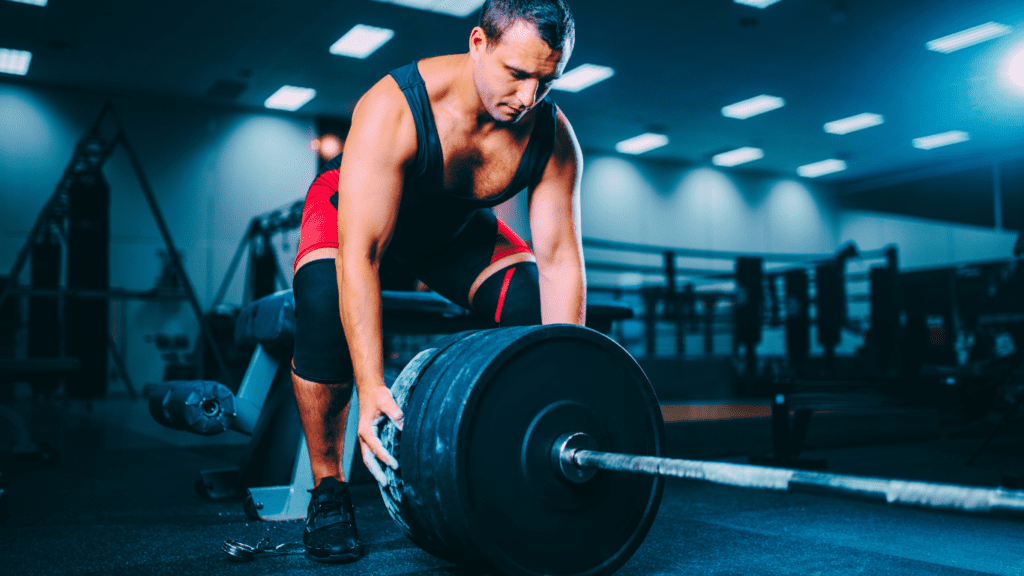
Importance of Recovery
Proper recovery is just as vital as training itself, especially when focusing on the big three lifts. Recovery involves various aspects, including sleep, active recovery techniques, and rest days. Each plays a significant role in preventing injury and enhancing performance.
- Sleep: Quality sleep is essential for muscle recovery and overall performance. Aim for 7-9 hours of sleep per night to support the body’s repair processes and optimize strength gains from your powerlifting routine. Poor sleep can impair muscle recovery, reduce strength gains, and increase the risk of injury. While bodybuilders also prioritize sleep, they might be more focused on sleep strategies that support muscle growth and recovery.
- Active Recovery Techniques: Incorporating active recovery techniques can enhance your performance in the big three lifts. These techniques include activities such as light cardio, stretching, and foam rolling. Active recovery helps to reduce muscle soreness, improve blood circulation, and accelerate the removal of metabolic waste products from the muscles. This is important for maintaining flexibility and mobility, which can enhance your lifting technique and performance.
- Rest Days: Incorporate rest days into your training program to allow your body to recover fully. Rest days are essential for muscle repair and growth and help prevent overtraining and burnout. For powerlifters, these rest days should be strategically placed to allow adequate recovery between intense lifting sessions. Bodybuilders also use rest days but may integrate more frequent low-intensity activities to support ongoing muscle growth while allowing specific muscle groups to recover.
Comparison with Other Workouts
The nutritional and recovery needs of powerlifters focusing on the big three lifts differ somewhat from those of individuals engaged in bodybuilding or other workout styles. For instance, bodybuilders often cycle their diet and training to focus on muscle hypertrophy and fat loss, which might involve more drastic changes in caloric intake and macronutrient ratios. They may also incorporate more varied training techniques and volume to achieve specific physique goals.
Endurance athletes, on the other hand, prioritize different aspects of nutrition and recovery. They often require higher carbohydrate intake to fuel prolonged exercise and may emphasize joint health and endurance rather than maximal strength. The principles of recovery remain similar—adequate sleep, proper hydration, and active recovery techniques—but the focus and application can vary based on the demands of the sport.
Optimizing your performance with the big three lifts hinges on a well-rounded approach to nutrition and recovery. Understanding the specific nutritional requirements for powerlifting, such as adequate protein intake, caloric management, and targeted supplementation, will support your strength goals and performance. Additionally, prioritizing sleep, incorporating active recovery techniques, and strategically planning rest days will enhance your ability to recover and progress effectively. By addressing these factors, you can ensure that your powerlifting journey with the big three lifts is both successful and sustainable.
Inspiration and Motivation for Mastering The Big Three Lifts
Engaging in powerlifting with a focus on the big three lifts—the squat, bench press, and deadlift—requires not just physical strength but also significant mental resilience. Maintaining motivation and a clear mental strategy can make a crucial difference in your success and enjoyment of the sport. In this section, we will explore key aspects of the mental game, provide insight into overcoming challenges, and emphasize the importance of a long-term perspective.
The Mental Game
Powerlifting is as much a mental challenge as it is a physical one. To truly excel with the big three lifts, you need to develop a strong mental approach that can help you navigate the ups and downs of training. Here’s how to tackle the mental aspects of powerlifting:
Setting Goals: One of the most effective ways to stay motivated in powerlifting is by setting clear, achievable goals. When focusing on the big three lifts, set both short-term and long-term objectives. Short-term goals might include improving your form or hitting a new personal record, while long-term goals could be achieving a specific total weight across all three lifts. Break these goals into manageable steps to make progress more tangible and keep yourself motivated. Regularly reassess and adjust your goals as needed to stay aligned with your progress and evolving aspirations.
Overcoming Plateaus: Plateaus are a common challenge in powerlifting and can be particularly frustrating when you’re working on the big three lifts. When progress stalls, it’s important to stay patient and avoid discouragement. Analyze your training program to identify potential issues—this might include adjusting your volume, intensity, or recovery strategies. Sometimes a change in technique or incorporating new exercises can help break through a plateau. Remember that plateaus are a normal part of the training process and overcoming them often leads to substantial progress and improved performance.
Staying Consistent: Consistency is crucial for making progress with the big three lifts. Establish a training routine that you can stick to over the long term. This involves not only regular training sessions but also maintaining proper nutrition and recovery practices. Consistency in your training will ensure steady progress and help you build a strong foundation for future gains. It’s also important to keep a positive mindset, even on days when motivation is low. Regularly remind yourself of your achievements and the reasons you started powerlifting to keep your motivation high.
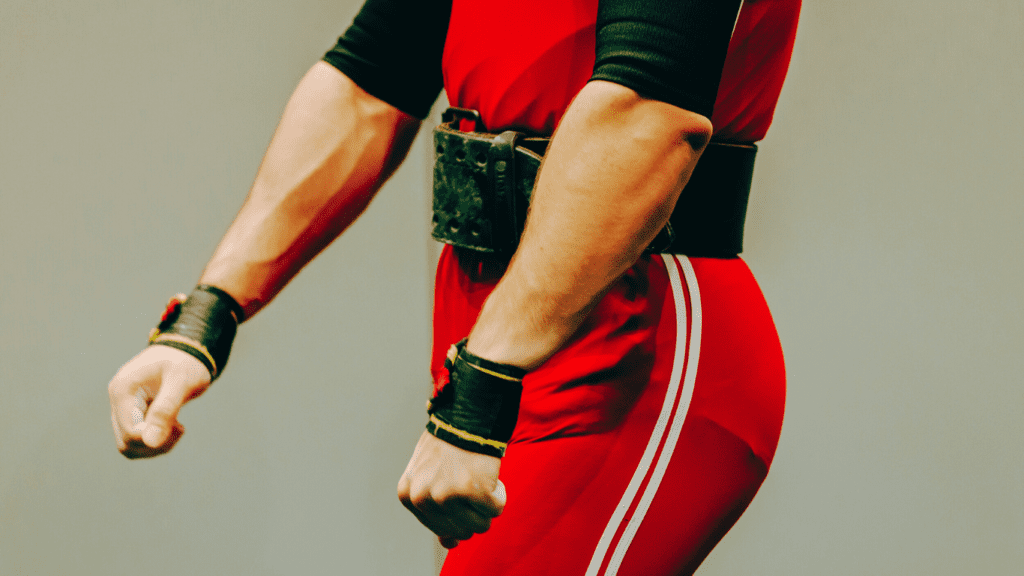
The Long-Term Perspective
Viewing powerlifting as a long-term journey rather than a quick fix is essential for sustained success with the big three lifts. Embracing this perspective helps you remain committed, handle setbacks effectively, and enjoy the process of continuous improvement. Here’s why a long-term perspective is beneficial:
Patience: Building strength through the big three lifts takes time and consistent effort. Understand that progress in powerlifting is often gradual, and achieving significant milestones requires patience. Avoid the temptation to seek quick fixes or shortcuts. Instead, focus on making steady improvements over time. This patient approach will help you avoid frustration and stay committed to your long-term goals.
Persistence: The journey with the big three lifts is filled with challenges, including physical and mental hurdles. Persistence is key to overcoming these obstacles. Embrace setbacks as learning opportunities and stay focused on your long-term goals. Persistence will help you push through difficult phases and continue to make progress, even when results seem slow.
Enjoying the Process: Finding joy in the process of training and improving with the big three lifts is crucial for long-term success. Celebrate your achievements, no matter how small, and take pride in your progress. Developing a passion for the process of powerlifting can help you stay motivated and engaged, making the journey more enjoyable and fulfilling.
Building a Sustainable Routine: Creating a training routine that fits your lifestyle and can be maintained over time is essential for long-term success. Incorporate variety into your training program to keep it interesting and prevent burnout. Make adjustments as needed to accommodate changes in your schedule or goals. A well-balanced routine that includes proper recovery, nutrition, and training will help you sustain progress and enjoyment in powerlifting.
Mastering the big three lifts involves more than just physical strength; it requires mental resilience and a long-term perspective. By setting clear goals, overcoming plateaus, and staying consistent, you can effectively navigate the mental challenges of powerlifting. Embracing patience, persistence, and enjoyment of the process will help you view powerlifting as a rewarding journey rather than a quick fix. With the right mindset and approach, you can achieve sustained success and fulfillment in your powerlifting endeavors.
Wrapping Up: Leveraging The Big Three Lifts for Lasting Strength and Success
As we conclude our exploration of the big three lifts—the squat, bench press, and deadlift—let’s recap the essential insights shared. Understanding and executing these core movements effectively can significantly impact your strength training journey, offering both physical and mental benefits. Here’s a summary of the key points and practical suggestions to help you integrate these lifts into your routine.
Recap of The Big Three Lifts
We’ve covered the foundational role of the squat, bench press, and deadlift in building overall strength and functional fitness. These exercises target major muscle groups, enhance stability, and contribute to a balanced strength development regimen. Each lift offers unique benefits and contributes to a comprehensive training program.
Incorporating The Big Three Lifts
Start integrating the big three lifts into your training routine by focusing on proper technique and gradually increasing intensity. Consistency and patience are crucial for making progress. Share your experiences with these lifts in the comments section to connect with others and stay motivated.
Inspiring Message
Strength training is a journey of self-improvement and resilience. Mastering the big three lifts can lead to significant gains and a profound sense of achievement. Embrace the challenge, celebrate your progress, and enjoy the journey of becoming stronger both physically and mentally.
Enhancing Your Lifting Experience
To optimize your performance with the big three lifts, consider investing in the following equipment:
- Lifting Shoes: Provide stability and support for squats and deadlifts.
- Weightlifting Belt: Offers back support and helps with heavier lifts.
- Wrist Wraps: Provide additional support during the bench press.
Additional Resources
To further your understanding and technique for the big three lifts, explore these recommended books:
- Squat: “Squat Every Day” by Pavel Tsatsouline – Insights into effective squat training and programming.
- Bench Press: “Bench Press: The Ultimate Guide” by Greg Nuckols – A thorough exploration of bench press techniques and progress strategies.
- Deadlift: “The Deadlift Manual” by Mike Israetel – Comprehensive guide on deadlift training, technique, and programming.
In summary, mastering the big three lifts is a powerful way to enhance your strength, performance, and overall fitness. Utilize the recommended books to refine your technique, stay motivated, and continue making progress. Embrace the journey, and let your dedication to the big three lifts lead you to new heights of strength and achievement.

